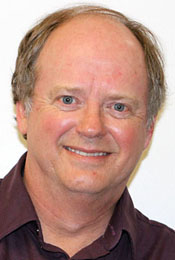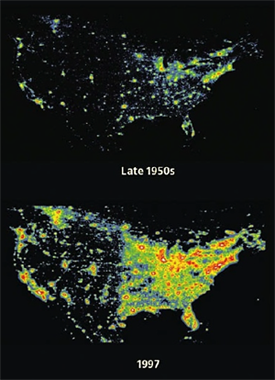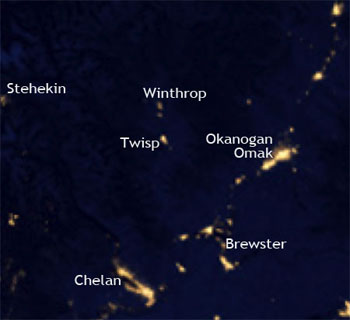 David Gottula, OCEC general manager. Photo: Solveig Torvik Star Bright
Dark Sky initiative
by Solveig Torvik
When he was working for a power company in Alamogordo, New Mexico, Okanogan County Electric Cooperative (OCEC) general manager David Gottula spent a lot of time pointing lights down at night.
“It was economic development,” he says. “We were trying to keep jobs, so we were trying to keep the lights shining down.”
And how did turning lighting downward translate into turning up the economy around Alamogordo? The area is home to space telescopes used by astronomers, and to function, the telescopes need dark night skies. There was money in darkening the nights, so to speak.
While there’s not much by way of jobs in astronomy in the Methow, Gottula argues that there are plenty of good reasons to point the Methow’s outside lights down at night. “It’s got to do with the ambiance,” he says, as well as the valley’s general economy, plus potential personal savings on the light bill.
 The amount of light at night in the United States has increased significantly in the last 40 years. People decide to live in the Methow Valley—or visit it—partly because it’s one of those increasingly rare places where humans can still see the night sky, says Gottula. “I like to look at the Milky Way at night,” he adds. He’s not alone. Our species seems to have been struck by primordial awe of the starry firmament from day one of our history on the planet.
But the number of human beings who can no longer see the heavens at night is shockingly apparent from NASA photos of night-time light pollution. Gottula will show those photos during a presentation of the co-op’s “Dark Sky” initiative at the organization’s general membership meeting April 15. One of them shows the effect of having Winthrop and Twisp lit up at night. “What we don’t want to do is to get like this,” he says, pointing to brightly-lit larger towns around us in the region.
Gottula’s request of the utility’s customers is simple: shine outside lights down, not up; get the bulb tucked up inside the light fixture. “A lot of our lights shine up,” he says. “The concept is not to get rid of the lights but to shine them down. Shine the light where you need it when you need it,” but not up into the sky.
Scientists have documented deleterious effects on wildlife from night lights, says Gottula. These include decline in reproduction in mammals and amphibians, high mortality among insects drawn to lights as well as high mortality among birds confused by lights; 100 million birds a year die in North America in collisions with lighted buildings and towers, according to the International Dark Sky Association, a non-profit organization that lobbies for light pollution reduction measures.
 A look at our local area from above at night. Valley residents became aware of the far-reaching effects of night light overkill during the recent public outcry over the airport beacon at the Methow Valley State Airport. “You could still have that [same effect] by a thousand points of light. You might as well have a beacon,” says Gottula.
“People want street lights all the time, while on the farms people want lights for security,” says Gottula. Some customers such as farmers who need outdoor night lighting pay the utility $8 per month for a light fixture owned by the utility. If all goes as expected, the bulbs in those lights soon will be replaced with some that are more dark-sky friendly, said Gottula.
And Winthrop’s streetlights, which use bulbs that last as little as two years, also may be replaced this summer with dark-sky friendly, filtered LED lights that are guaranteed for five years but have a life expectancy of 10 to 15 years, he said. Each new LED bulbs costs about $230, but because they are more energy-efficient than present bulbs, the Bonneville Power Administration will pay $120 of the cost, said Gottula. All told, the utility hopes to install 80 of the new LED light bulbs, according to Gottula.
Meanwhile the utility is trying to practice what it preaches. It has turned off four bright lights at its substation, for example, and installed dark-sky friendly lights in its own parking lot.
 This light at the Okanogan County Electric Co-op parking lot shines down, not out and up. Photo: Solveig Torvik The co-op also has joined the International Dark-Sky Association and will try to educate the co-op’s 3,400 members on the need for shining lights down, said Gottula. It will also try to persuade local light fixture suppliers to carry them so customers can buy them locally.
The co-op’s s annual meeting will be April 15 in the Winthrop Barn with registration at 6 p.m. and meeting at 7 p.m.
4/4/2013
see past stories in the archive >>
|
